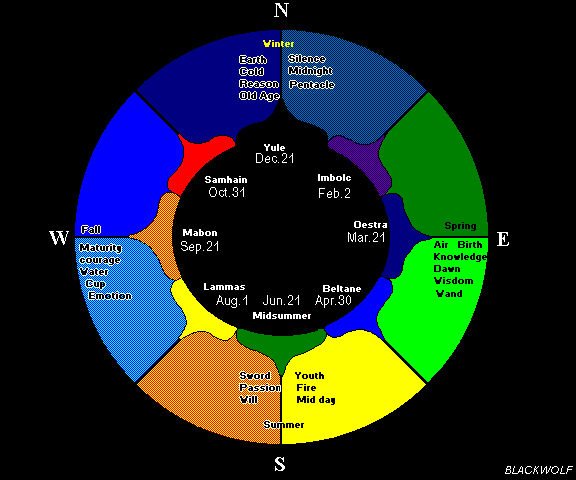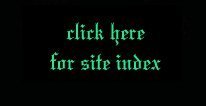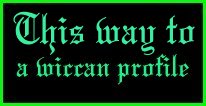

this is what a wiccan year is

![]()




![]()

The first celebration of Winter and the day in which the Celtic
New Year begins. A time for both
beginnings and endings, through death in Winter to rebirth in
Spring. In ancient times the celtic people celebrated the Celtic Feast of the Dead to honor the memories of their ancestors. Witches today often share this custom by lifting the veil on this night of high psychic charge to contact their own ancestors. Spells are also performed to do away with old negative patterns or situations to make room for new life. Samhain is also known as Hallomas, Samana, Samhuinn and Samonios (Halloween in modern christian times as well). The colors are black and orange. Symbols are the cauldron, jack o'lantern, mask, and balefire. Dieties for this Sabbat are Crone Goddesses, Dying/Aging Gods, Sacrificial Gods, Death and Otherworld Gods and Goddesses.
Yule - Winter Solstice -December 21
Yule is the Winter Solstice, the shortest day and longest night of the year. The precise date will change year to year. The darkest time between Samhain and Yule draws to an end as the Goddess,Mother Earth, gives birth to the Sun again. It is a sabbat for fond memories, reflection on the interconnectedness of all and glory of knowing the Sun has been rebirthed and his rays of warmth will soon start to spill upon us. Yule is also known as Midwinter and Fionn's Day (Christmas is the christianization of Yule). Yule colors are red, green and white. Symbols are the Evergreen, wreath, Yule Log, holly and spinning wheels. Dieties for this Sabbat are Newborn Gods, Triple Goddess and the Virgin Goddesses.
Imbolc (EM-bowl'k) - February 1st
Imbolc is the Sabbat that celebrates and honors the Goddess as the bride-to-be of the returning Sun God. The soon arrival of the plant life whispering beneath the soil, the full warmth of the Sun God being birthed from the Imbolc Virgin Goddesses womb, the romise of fertility that is celebrated on Beltaine, are all honored on this sacred day. Witches typically charge and annoint seeds that are harbored by their hearths until Ostara, the day in which they are planted. Imbolc is also known as Oimelc, Brid's Day and Bride's Day. Imbolc colors are white, pale yellow and silver. Symbols are candles, grain, burrowing animals, ewes and marigolds. Dieties for this sabbat are Gods as Young Men, Boys or infants, Virgin, Maiden or Child Goddesses.
Ostara - Spring Equinox - March 20
Ostara is the Sabbat of Balance. The days and nights are of equal
length but the Sun God is gaining more power over the darkness of Winter. Ostara is also celebrated as the time of courtship of the God and Goddess in preparation for their consumation on Beltaine. Witches typically plant the seeds that were annointed on Imbolc on this Spring Equinox. Ostara is also known as Eostre or Lady Day. Ostara colors are anything soft and muted such as pastels. Symbols are the egg, equilateral cross and the butterfly. Dieties for this sabbat are Youthful Gods and Goddesses, Warrior Gods, and Faerie Queens.

"I see you found me!"
Beltane - May 1
As Samhain was the beginning of the cycle of Winter, Beltane marks the second major cycle of the year: Summer. This May Sabbat is a celebration of new life in all
it's forms. This is the day God and Goddess are united in sacred marriage, their relationship consumated. This melding of God and Goddess symbolically fertilizes the animals and crops for the rest of the year. Witches celebrate the great fruitfulness of the earth and the exuberance of spring this night with a playful sense of carefree abandon. This is the traditional day of pagan handfastings. A vow made between two witnessed and blessed by the God and Goddess that commonly lasts for a year and a day (which then can be continued for life). Jumping over broomsticks and dancing around the maypole typically entwining the red and white ribbons (symbols of the God and Goddess) are both symbols of fertility. May Day is a good time for Fire and Fertility magicks. Beltane is also known as May Day, Bealtaine, Rudemas, Giamonios and Bhealltainn. Beltane colors are red and white (symbolizing the God and Goddess). Symbols are the May Pole, baskets, flowers and the butterchurn. Dieties for this Sabbat are Flower Goddesses, Divine Couples, and Dieties of the Hunt.M
Midsummer - Summer Solstice - June 20
Midsummer is the time when Father Sun reaches the highest power, Mother Earth is green and holds the promise of a bountiful harvest. While steamy Midsummer marks the beginning of the Sun's dying strength the season itself is very lush, erotic and sexy. The Sun, flowers and Earth are in full bloom. Hot Midsummer creates a fiery, mature, breathless passion. Midsummer is also known as Litha, Feill-Sheathain, and Gathering Day. Midsummer color is green. Symbols are Fire, sun dials, feathers, and swords/blades. Dieties for this Sabbat are Gods at Peak Power and
Strength, and Pregnant, lusty Goddesses.
Lughnasadh (Loo-NAHS-ah)- August 1
Lughnasadh is a grain harvest festival. The Goddess is honored as the Mother who has given birth to bounty and abundance and the God as Father of Prosperity. This is the first harvest on the Wheel of the Year. The splendor of the bountiful cornucopia of wheat, fruits and vegatables is also reflected upon as it pertains to our lives. Lughnasadh is also known as Lammas, Elembiuos and August Eve. Lughnasadh colors are gray, green, yellow and gold. Symbols are threshing tools, breads, cornucopias and all grains. Dieties for this Sabbat are Harvest and Grain Dieties and New Mother Goddesses.
Mabon - Autumn Equinox - September 21
Mabon is the second harvest festival on the Wheel of the Year. This Sabbat particularly celebrates the harvests of the vine, wine and apples as symbols of life renewed. Partaking of the fruits of this season as well as leaving apples upon burial cairns and graves as a token of honor are all common neopagan and Old Celt practises. There is a thankfulness for this abundance as well as a wish of the living to be be in touch with the dead which comes up in Samhain. Mabon is also known as Feast of Avalon and Wine Harvest. Mabon colors are russet, maroon, orange and all the colors of autumn. Symbols are the apple, wine, vine, gourd, cornucopia, burial cairns and garland. Dieties for this Sabbat are Wine Gods, Aging Gods and Goddesses and Harvest Dieties.



© 1997 therentece@geocities.com
This page hosted by  Get your own Free Home Page
Get your own Free Home Page
